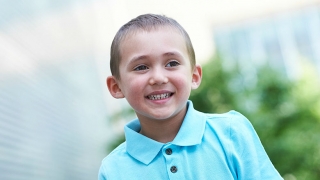Mark Egan, now 16 years old, wrote a story about his brain cancer diagnosis, treatment and relapse when he was in eighth grade. Since this was written, Mark also received proton therapy, a more targeted form of radiation treatment.
Long ago, when I was three years old, I acted like no normal toddler would. I bumped into chairs, sofas, tables, walls and many other things as well.
Finally, my mom decided to have an MRI done on me at The Children's Hospital of Philadelphia. When the MRI was done and the doctors came out, they explained that I had a significantly large tumor.
After this, I was taken for a surgery but it was no success. That was when I was operated on by a surgeon in New York. Here, my mom found hope and my life was saved.
Chemotherapy to shrink tumor
In later years, when I was in kindergarten, I was given chemotherapy through a needle and port which was located in my chest. With a port, the process of getting a needle and having medicine injected is easier. This medication was given to try and get my tumor to stay the same or decrease in size.
After some time of being on this medication and having an MRI every three months, my doctor started to notice that the size of the tumor was shrinking. As a result, my doctor took me off of this medication and only required a monthly MRI scan.
Several years after being off of chemotherapy, with a monthly MRI, my doctor began to notice a major growth in the tumor. After this, I was put back on chemotherapy. This time, my doctor decided to keep me on chemo from then, in fifth grade, until now, in eighth grade.
Between those times I had another surgery done on the brain tumor, again in New York. This surgery was done because for the second time my doctor saw growth in the tumor.
After this surgery, my surgeon had done just as well as my second surgeon. A large portion of the tumor was removed as well as two cysts, which help the tumor do its job.
After this, I continued taking weekly chemotherapy, as well as an MRI every three months. And today I am stabilized.
Lessons learned
From this experience I have learned many lessons. In my time of having a brain tumor I have learned to be brave. I have learned this because of all the unbearable things I've been through such as numerous needles and MRIs.
I have also learned to be strong. This I have learned because of the bad news or bad things I've seen and heard, such as having a surgery or going back on chemotherapy.
Last, I learned how to be thankful.
When I go to Children's Hospital and look at the other patients in the hospital I think of them and then myself. When in this thought I realize how lucky I am.
When I look around at all the other patients and their condition, I see some in the same condition as me. However, I also see others who are without hair, have odd looking skin and walk or move in an abnormal way. From these lessons I have been shaped into who I am. From these lessons I have made great friends, I have thought of myself equal to fellow classmates and have acted just as any other student does in a normal life.
Sharing what I've learned
With my tumor I have also taught my friends and teachers most of the lessons I learned. I have taught them to be strong. I have taught them to be brave and stick up for themselves. I have taught them to believe in themselves and do what they wish to do.
I have taught them that even with this "issue" I can still carry on as any other student does. And last, I have taught them that I am no different than you, except for the fact that my eye wanders and that I should never be given more or less credit than what I deserve.
My life with a brain tumor has been a long process. Going back to when I was three and the tumor was discovered, to the time I began chemotherapy when I was in preschool all the way to now when I'm still on chemo. I have taught my friends and teachers from preschool to today about my tumor.
And whenever new friends or new teachers hear about me they all can't believe the story. But today I live on, just as any normal child does in a normal life, with some extra events in between.
By Mark Egan, January 2012
